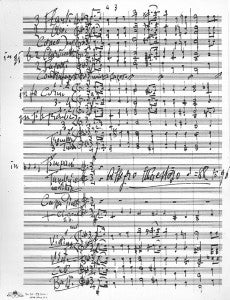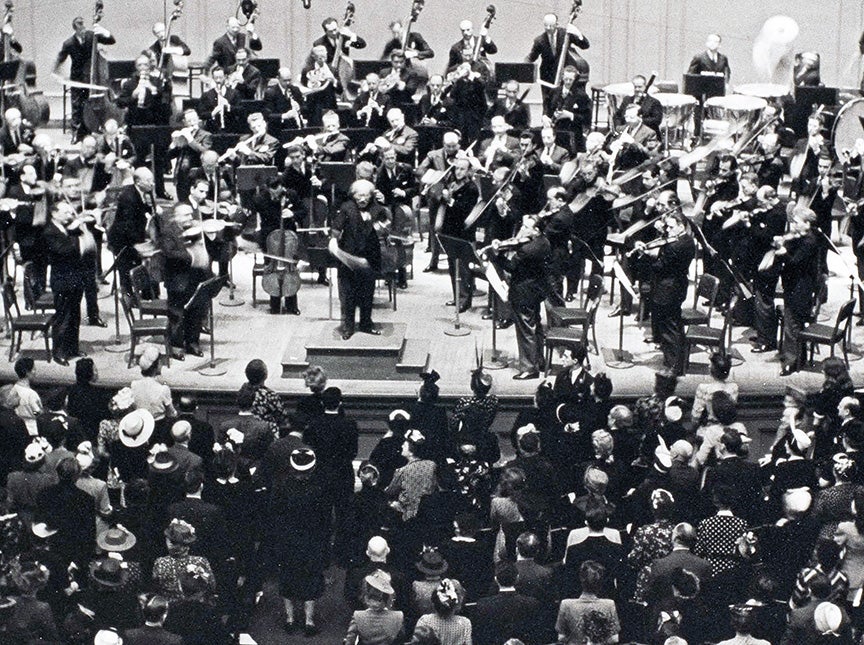
The New York Philharmonic will perform Arturo Toscanini’s World War II orchestral arrangement of “The Star-Spangled Banner” for its Star Spangled Celebration concerts on July 4, 5, & 6 (conducted by Bramwell Tovey) and July 14 in Central Park & July 18 in Vail, Colorado (conducted by music director Alan Gilbert). (See press release.)
The new edition was created by musicologist Mark Clague working with students from the University of Michigan’s Undergraduate Research Opportunity Program. With the encouragement of the Toscanini family, after the premier of the new score the edition will be distributed free of charge by the Star Spangled Music Foundation for educational performance. The project was facilitated by New York Philharmonic Archivist/Historian Barbara Haws, who provided copies of the source material and coordinated the arrangement with the conductor’s heirs.
Toscanini’s unpublished, hand-written score was given to the New York Philharmonic archive soon after it was purchased by Philharmonic board member William Rosenwald at a fundraising auction in 1952. Toscanini had given the score to the Friends of the New York Philharmonic and Rosenwald bought and then donated the manuscript back to the orchestra. It has apparently remained unperformed in the orchestra’s archive for decades.

The internationally celebrated Italian conductor Arturo Toscanini (1867–1957) served as music director of the New York Philharmonic from 1926 to ’36 and returned to the U.S. in 1937 to lead the NBC Symphony Orchestra, which had been created for him. His weekly national radio broadcasts brought his music making into homes across the United States.
An ardent anti-fascist, Toscanini adopted the anthem of his new country during the World War II era, arranging it as the grand finale of Giuseppe Verdi’s Hymn of the Nations for a January 1943 broadcast including soloist and choir. In April of that year he arranged the anthem for symphony orchestra, premiering this version at a War Bonds Concert and auctioning off his handwritten score to the person with the highest bid to purchase additional bonds. He later recorded the work to benefit the Red Cross and filmed Verdi’s Hymn as a War Department propaganda piece. In 1951, he modified his original 1943 draft score for donation to the New York fundraising effort.
Toscanini’s “Banner” uses traditional harmonies, akin to Walter Damrosch’s familiar WWI-era arrangement. The Italian conductor’s original expressive contributions are thus located elsewhere — in the grandeur of the especially slow tempo and rich orchestration, including the added bass voices of English horn, bass clarinet, and contrabassoon. Rolled chords in the winds and strings animate a hymnlike presentation of the melody. Francis Scott Key’s lyrical invocation of “rockets” and “bombs” inspires a fervent brass countermelody accompanied by repeated, militaristic notes in the horns. Toscanini sets the final phrase of Key’s text and its vision of freedom as the song’s emotional climax — stretching the tempo, raising the dynamic to its maximum, filling out the harmony with passing tones as well as trills in the inner voices, and extending cadential repose with fermatas. The percussion is also finally unleashed for this climactic grandioso, made all the more dramatic because of the limited role for drums and cymbals until this point. Toscanini thus offers a compelling personal tribute to the United States, one that would have been even more impressive when propelled by the maestro’s vigorous conducting style.
Thanks go to U-M undergraduate student Daniel Reed and recent composition DMA Michael-Thomas Foumai for their assistance in engraving the score for the new edition.
For tickets see www.nyphil.org

